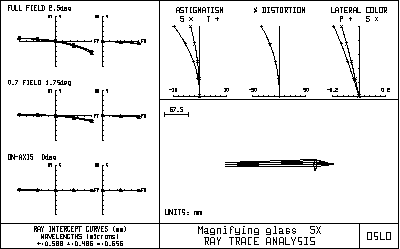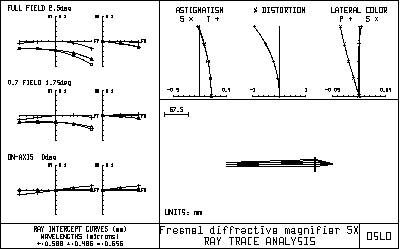MAGNIFYR.LEN - A CONVENTIONAL 5X MAGNIFIER
Magfrenl uses a Fresnel surface to correct the geometrical aberration and a diffractive surface to correct the chromatic aberration of a simple magnifier. Magnifyr is a plano-convex singlet set up as a visual magnifier. It shows how to set up the pupils for such a system, and serves as a base system used to compare the performance of a Fresnel magnifier. This lens is an ordinary 50mm focal length singlet, 31mm diameter, set up as it would be for use as a visual magnifier. The eye relief has been assumed to be 250mm, and the pupil diameter has been taken as 10mm to provide freedom of eye movement. This lens has been included in the demo library mainly for comparison to the Fresnel diffractive magnifier (magfrenl.len). A great deal of caution needs to be exercised in interpreting the ray analysis for a visual instrument such as a magnifier, because the eye is neither in a fixed position, nor at a fixed focus. The eye (particularly a single eye) can tolerate rather poor imagery, but tends to be intolerant of imagery that changes rapidly with eye position.

MAGFRENL.LEN - A FRESNEL DIFFRACTIVE MAGNIFIER
Magfrenl uses a Fresnel surface to correct the geometrical aberration and a diffractive surface to correct the chromatic aberration of a simple magnifier. This example can be used to see how to enter data for these systems, or more importantly to understand the difference between a Fresnel and a diffractive surface. The Fresnel diffractive magnifier is a plastic element with an aspheric Fresnel surface on the front and a diffractive surface on the back. It is an interesting system for both its tutorial value and its optical performance. The optical performance is much better than that of a simple lens, as shown by the ray analysis below. 
A Fresnel surface in OSLO is one that has the power of a curved surface, but is actually placed on a substrate having a different curvature (usually flat). This is accomplished by dividing the surface into prismatic zones, so that the surface normal approximates that of the curved refracting surface at any point. As the number of zones increases, the approximation becomes better. Fresnel surfaces were originally used in searchlights, where a substantial reduction in weight was accomplished. More recently, Fresnel surfaces have been used in a variety of consumer optics products made from embossed plastic. A diffractive surface is outwardly similar to a Fresnel surface, but there is an important difference between the two: With a Fresnel surface, light from different zones combines incoherently, while with a diffractive surface, light from different zones combines coherently. The former follows the laws of refraction, while the latter follows the laws of diffraction. Curiously, the chromatic aberration of the two has opposite sign, which is used in the magfrenl.len magnifier. The lens data is shown below. *LENS DATA Fresnel diffractive magnifier 5X
| SRF | RADIUS | THICKNESS | APERTURE RADIUS | GLASS SPE | NOTE |
| 0 | -- | 1.0000e+20 | 4.3661e+18 | AIR | |
| 1 | -- | 250.000000 | 5.000000 A | AIR | |
| 2 | 32.626000 | 2.000000 | 20.000000 | CARBO C * | |
| 3 | -- | 48.700000 | 20.000000 | AIR * | |
| 4 | -- | -- | 5.000000 |
| SRF | CC | AD | AE | AF | AG |
| 2 | -0.969340 | -1.5465e-07 | -- | -- | -- |
| 3 | DOE DFR | 2 - SYMMETRIC DIFFRACTIVE SRF | DOR | 1 DWV | 0.587560 |
| DF0 | -- DF1 -0.001041 |
| 2 | FRN | 1 | FCV | -- | FCC | -- |
